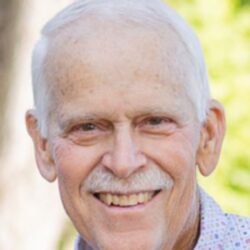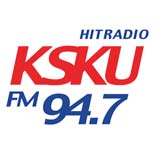By Brenna Eller

BAKER, NV — Each October, Radio Hobbyist of 50 years, Tim Hall, goes out to the desert on the Nevada-Utah border near Baker, NV, and rolls out long wires to hear faraway AM stations. He spends the rest of the year going through all the recordings to listen to what he has caught.
Over the Easter weekend, Ad Astra Radio was contacted by Hall for confirmation of his recordings of KMCP 1540 AM and KLQR 1510 AM.
Hall heard KMCP 1540 AM October 30, 2023, at 6:56 a.m. Central Daylight Time. He heard the phrase, “McPherson news, sports, and classic hits, 98.9 AM 15-40, KMCP.”
Hall noted that the song that played before the liner may have been Mustang Sally. He also said that he heard KMCP on a 2-Watt night power at a distance of 882 miles from KMCP’s transmitter site.
Hall also got a recording of KLQR 1510 AM at 6:55 a.m. October 30, 2023.
KLQR was on a 66-Watt pre-sunrise power at the time and Hall was 807 miles from that transmitter site. The liner he caught was “Stream KLQR with the Ad Astra radio app. Get your free download for iPhone or Android. Larned’s news and classic hits, 15-10 KLQR.”

KLQR and KMCP were both picked up with an 1100 foot-long-wire aimed just a bit north of us according to Hall.
Hall was born in San Diego and has lived most of his life there, with his dad being a Navy pilot. Hall said he isn’t your typical Californian though and was fortunate to grow up in Virginia.
In 1972, when his family lived in Virginia, his dad bought him a multi-band receiver, (an AM, FM, shortwave, police band) as a birthday present. A few nights later, he heard a Cincinnati Reds game on WLW and started to understand how AM signals travel at night.
“Before I knew it, I was hearing stations from up and down the east coast,” Hall said. “I also listened to shortwave and some other bands and even some TV and FM signals (channels 2 through 6 and FM can occasionally bounce back to earth about 1000 miles away, especially between May and July). But I always kept coming back to AM radio.”
In high school, Hall continued to just listen overnight on Sunday nights for faraway stations. But back in those days, he said radio transmitters were a lot more “finicky,” and the engineers often used to take the stations off the air between Midnight and 6 a.m. for maintenance and testing, which sometimes left “openings” to hear stations from farther away.
“As a young man, I would stay up all night on my night off. Back then, we were still using traditional “one frequency at a time” radio receivers which were optimized for long-distance reception as opposed to great audio quality,” Hall said.
Nowadays, hobbyists like Hall use SDRs (software-defined radios, controlled by a laptop) which are capable of recording the entire AM band all at once, allowing you to “tune” the recordings during playback, just as if you were tuning a live radio.

Over the years, Hall and his wife, Karen would take long road trips around the western states and often booked overnight stays in smaller towns where Hall would have fewer local signals to get in the way of his long-distance listening efforts.
“That’s how I discovered my favorite location on the Nevada-Utah border, where I’ve picked up KMCP and KLQR,” he said. “Back in 2002, I had a few days off before a business trip to Las Vegas, so we drove up there to see Great Basin National Park, and I brought some antenna wire with me.”
Now that he is retired, Hall has the time to devote to his longtime hobby. When he goes to the desert in October, he makes about 150 recordings over the course of four or five nights, and to review the recordings, which are around 119 AM channels with an average of about three to four minutes per recording, it takes about 800 or 1,000 hours, which takes the course of about 10 months overall.
“The remaining two months, I update my master station list, and pick out ‘target’ stations to try to hear on my next trip’,” Hall said.
People may wonder what it is about listening to faraway stations that interests hobbyists like Hall. His answer to why he enjoys it is because it’s a good challenge for him, like other traditional hobbies are for people, such as birdwatching.
“The more stations you’ve heard, the harder it is to hear the next new “catch.” You have to figure out the very best dates/times to try for each station, the exact angle to aim your antenna, and so forth. We share our catches with each other via radio club bulletins and social media and compete with each other for long-distance receptions of low-powered stations,” Hall said. “I also love hearing REAL radio stations from the heartland, like KMCP. The local programming, community calendar, high school football games, and other quality local content is a really nice change from the cookie-cutter ‘corporate’ radio stations in the big cities.”
Hall added that local stations like KMCP and KLQR remind him of his youth, when virtually all radio stations were locally owned and put real effort into their programming.

Ad Astra Radio’s stations also remind him of the long cross-country road trips his family would take when he was a kid, as his dad (a Navy officer) was transferred back and forth between the west and east coasts.
Hall said that the wonderful thing about the location he listens from at the Nevada-Utah border is that there are so few AM radio stations anywhere near it with only two AM broadcasting stations within 100 miles, one in Ely Nevada (48 miles by air) and another (currently off the air) in Delta Utah (82 miles by air), both with low power.
“The site is mostly surrounded by flat open desert so I can roll out wires in almost any direction,” Hall said. “It has a roadside motel, gas station, convenience store, and a restaurant with great hamburgers, so I don’t have to drive anywhere while I’m there. Mind you, it gets pretty cold, and the wind occasionally gusts to 50 MPH (which can snag and even break my wires in the thorny sagebrush), so it does have its challenges! I can’t complain, because I have radio hobbyist friends in Norway and Finland who go up above the Arctic Circle and aim their wires over the North Pole to hear just about anything in the world.”
According to Hall, back in the 80s in San Diego, when there were fewer stations on the AM dial and less interference from electronics, it was easier to hear Australia and New Zealand on AM in the summer, Japan and Korea in the spring, and even Russia in the winter.
“In the other direction, I could hear stations in the Caribbean and South America,” Hall said. “Even today I can still hear a few of the big Japanese and Korean stations from my backyard in the early morning.”
From his desert listening post on the Nevada-Utah border sitting in his car on the Utah side facing the “Welcome to Nevada” sign a few hundred feet in front of him, Hall has caught a few Australian signals.

“At about 8,000 miles away, those signals have to make about 8 “hops” bouncing off the earth and the ionosphere to get to me, so there’s not much left by the time they reach my location,” He added. “I more frequently hear signals from high-powered stations in Japan, North and South Korea, Taiwan and China at about 5,000 miles, as well as stations from Puerto Rico, Colombia, Venezuela, Brazil and Argentina (3,000 to 5,000 miles). I’ve even heard one faint signal from a station in Spain.”
Overall, from his desert listening post, Hall has heard 1,967 stations from 44 states (plus DC), 6 Canadian provinces, 24 Mexican states (plus Mexico City) and 25 countries. He still has about 60 recordings left to review from last October’s trip and has hopes that those numbers will go up a bit.
Last year, Hall’s band made a recording of a song, “I’m Counting on You” with country artist, Vince Gill.
“It’s Vince Gill ‘crooning’ with a big band!” Hall said. “He wrote the song and stopped in San Diego to record it with us.”
Hall is the bass trombone player in the band and can be seen in the video around 0:50 and again just after the 2-minute mark: https://www.tinyurl.com/ira-vince-gill (The song is available online in all the usual places according to Hall).



























































